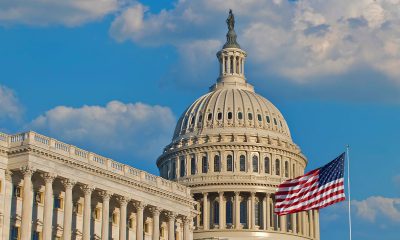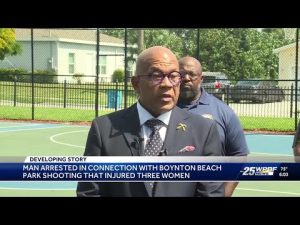#NNPA BlackPress
COMMENTARY: Young voters are going to be key to winning 2020
THE ATLANTA VOICE — In 2018, the youth vote increased in all 42 states for which youth voting data is available, according to the analysis by researchers at Tufts’ Center for Information & Research on Civic Learning and Engagement (CIRCLE). Based on this available data, which represents 94% of the American youth population, Tisch College researchers estimate 28.2% of young people nationwide voted in 2018 — more than double the national youth turnout in 2014.
By Dan Glickman and Alan Solomont
Politics is in realignment. And perhaps the most underappreciated change is this: Based on recent research at Tufts University’s Tisch College of Civic Life, young voters, ages 18-29, played a significant role in the 2018 midterms and are poised to shape elections in 2020 and beyond.
For decades, this age bracket has turned out at lower rates than older voters, particularly in midterm elections. While experts have often attributed this to apathy, a complicated set of reasons may explain low turnout, including barriers to access, suppression, waning civic education and historic disadvantages. Despite these headwinds, 2018 marked a turning point.
In 2018, the youth vote increased in all 42 states for which youth voting data is available, according to the analysis by researchers at Tufts’ Center for Information & Research on Civic Learning and Engagement (CIRCLE). Based on this available data, which represents 94% of the American youth population, Tisch College researchers estimate 28.2% of young people nationwide voted in 2018 — more than double the national youth turnout in 2014.
Turnout among college students — an important subset of the youth vote — was even more impressive in 2018, at 40.3%. Research also showed that young voters preferred Democrat House candidates by 35 points, a massive margin that helped Democrats win back the House and far exceeded the highest gap of 27 points from 2008.
National statistics set the scene, but the stories on the ground are even more compelling.
Both parties have long tried to activate young voters, but with limited success. In 2018, however, Katie Porter, a law professor at the University of California, Irvine who won California’s 45th congressional district, hired an organizer specifically for campus outreach and campaigned on college campuses in the area.
In April 2018, Porter’s campaign had been listed in the Youth Electoral Significance Index, produced by Tisch College’s CIRCLE, as one of the top congressional races where young people could make the biggest impact, because of its youth population, prevalence of colleges, voter registration rates, historic turnout rates and turnout patterns where young people historically vote differently than older voters. Indeed, turnout in precincts on or near the UC Irvine campus surged in 2018, and outreach among young people has been credited as one reason for her victory.
Sen. Jon Tester’s win in Montana and Rep. Ayanna Pressley’s primary victory in the Massachusetts 7th District were also powered by youth turnout, according to research from CIRCLE.
Campaigns go where the votes are, and it’s still true that older voters are more reliable voters, especially in midterm and off-year elections. But increasing youth participation can have a tremendous impact on elections at all levels. And research tells us that voting is habit-forming. Those who begin to vote early are more likely to vote often and throughout their lives.
One election cycle isn’t a trend, but youth activists are certainly trendsetters when it comes to driving national conversations around public policy. On issues ranging from climate change to gun violence to voter suppression, young people are speaking up and encouraging their peers to register and vote, as we saw most recently during the climate strikes.
There is also increasing evidence that colleges and universities are getting involved. A recent report by Tisch College’s Institute for Democracy & Higher Education found that half of colleges that responded are using their college-voting data to guide campus conversations about engagement, and nearly 60% are using that data to mobilize voters.
College campuses have always been hotbeds of student political activism, but the rate of engagement from these voters in 2018 is historically large. This can be attributed, at least in part, to colleges and universities investing in the civic development of their students by embedding political and policy discussions in classroom learning, encouraging non-partisan voter registration and helping students confront consistent barriers to electoral participation (such as providing information about where and when to vote).
This is happening, for example, at James Madison University in Virginia; De Anza College, a community college in Cupertino, California; and the University of Texas at Austin.
As we head into 2020, both parties should focus more of their efforts on young voters. Their importance is often overlooked and dismissed by party leaders who assume their votes are “in the bag” for Democrats, or “gone forever” for Republicans.
Young people, who are less likely to respond to surveys, may be underrepresented in polls leading up to the election, especially if turnout remains high. Campaigns that base their outreach on these polls are taking a big risk if they ignore the importance of engaging with young people.
Both parties should get serious about courting this emerging part of the electorate, and that means seeking and valuing their input more and involving them in campaigns, or even encouraging them to run campaigns of their own.
Democrats shouldn’t take the current preference among young voters for granted. Young voters are suspicious of political parties, and their loyalty to either party is not particularly set. At least, not yet.
Republicans have a steep hill to climb when it comes to capturing more of the youth vote, but it is worth the effort. Donald Trump’s Republican Party has a strategy aimed at turning out a higher percentage of older voters, who tend to vote conservative. But there will be a Republican Party long after President Trump, and if that party hopes to compete, it will need to persuade younger voters to support its candidates.
Republicans may do particularly well if they focus on younger voters with libertarian tendencies. One possible reason, according to CIRCLE, is that young people are dissatisfied with the high amount of political polarization the United States has seen since the 2016 election.
If the GOP is committed to reaching new voters and trains its eye on this widely distributed and growing demographic, it may be forced to moderate its agenda and move more toward the middle of the political spectrum. Young voters in general hold more liberal views on nearly every issue than the current Trump-led Republican party ideology.
But as previously noted, young people are also not keen to identify with the Democratic party in particular. If they break from party dogma and adopt more moderate positions on issues such as climate change, the GOP might be surprised at the willingness of young voters to listen to their pitch for support. This may also put pressure on Democrats to take young people even more seriously and better respond to their demands for action on climate change and other issues.
However the data is interpreted by either party, the mere fact that this many young voters are engaging in the democratic process is a sign of future strength compared with the current national political frailty. With the passage of time, young Americans will inherit this country and its experiment in self-governance. To see them making their voices heard now gives us both hope.
This article originally appeared in The Atlanta Voice.
#NNPA BlackPress
LIHEAP Funds Released After Weeks of Delay as States and the District Rush to Protect Households from the Cold
BLACKPRESSUSA NEWSWIRE — The federal government has released $3.6 billion in home heating assistance after a delay that left states preparing for the start of winter without the program’s annual funding.

By Stacy M. Brown
Black Press USA Senior National Correspondent
The federal government has released $3.6 billion in home heating assistance after a delay that left states preparing for the start of winter without the program’s annual funding. The Low-Income Home Energy Assistance Program, known as LIHEAP, helps eligible households pay heating and cooling bills. The release follows a shutdown that stretched 43 days and pushed agencies across the country to warn families of possible disruptions.
State officials in Minnesota, Kansas, New York, and Pennsylvania had already issued alerts that the delay could slow the processing of applications or force families to wait until December for help. In Pennsylvania, more than 300,000 households depend on the program each year. Minnesota officials noted that older adults, young children, and people with disabilities face the highest risk as temperatures fall.
The delay also raised concerns among advocates who track household debt tied to rising utility costs. National Energy Assistance Directors Association Executive Director Mark Wolfe said the funds were “essential and long overdue” and added that high arrearages and increased energy prices have strained families seeking help.
Some states faced additional pressure when other services were affected by the shutdown. According to data reviewed by national energy advocates, roughly 68 percent of LIHEAP households also receive nutrition assistance, and the freeze in multiple programs increased the financial burden on low-income residents. Wolfe said families were placed in “an even more precarious situation than usual” as the shutdown stretched into November.
In Maryland, lawmakers urged the Trump administration to release funds after the state recorded its first cold-related death of the season. The Maryland Department of Health reported that a man in his 30s was found outdoors in Frederick County when temperatures dropped. Last winter, the state documented 75 cold-related deaths, the highest number in five years. Rep Kweisi Mfume joined more than 100 House members calling for immediate federal action and said LIHEAP “is not a luxury” for the 100,000 Maryland households that rely on it. He added that seniors and veterans would be placed at risk if the program remained stalled.
Maryland Gov. Wes Moore used $10.1 million in state funds to keep benefits moving, but noted that states cannot routinely replace federal dollars. His administration said families that rely on medical equipment requiring electricity are particularly vulnerable.
The District of Columbia has already mapped out its FY26 LIHEAP structure in documents filed with the federal government. The District’s plan shows that heating assistance, cooling assistance, weatherization, and year-round crisis assistance operate from October 1 through September 30. The District allocates 50 percent of its LIHEAP funds to heating assistance, 10 percent to cooling, 13 percent to year-round crisis assistance, 15 percent to weatherization, and 10 percent to administrative costs. Two percent is used for services that help residents reduce energy needs, including education on reading utility bills and identifying energy waste.
The District’s plan lists a minimum LIHEAP benefit of $200 and a maximum of $1,800 for both heating and cooling assistance. Crisis benefits are provided separately and may reach up to $500 when needed to resolve an emergency. The plan states that a household is considered in crisis if it has been disconnected from energy service, if heating oil is at 5 percent or less of capacity, or if the household has at least $200 owed after the regular benefit is applied.
The District’s filing notes that LIHEAP staff conduct outreach through community meetings, senior housing sites, Advisory Neighborhood Commissions, social media, posters, and mass mailings. The plan confirms that LIHEAP applicants can apply in person, by mail, by email, or through a mobile-friendly online application and that physically disabled residents may request in-home visits.
As agencies nationwide begin distributing the newly released funds, states continue working through large volumes of applications. Wolfe said LIHEAP administrators “have been notified that the award letters have gone out and the states can begin to draw down the funds.”
#NNPA BlackPress
Seven Steps to Help Your Child Build Meaningful Connections
BLACKPRESSUSA NEWSWIRE — Swinging side by side with a friend on the playground. Sharing chalk over bright, colorful sidewalk drawings. Hiding behind a tree during a spirited game of hide-and-seek. These simple moments between children may seem small, but they matter more than we think

By Niyoka McCoy, Ed.D., Chief Learning Officer, Stride/K12
Swinging side by side with a friend on the playground. Sharing chalk over bright, colorful sidewalk drawings. Hiding behind a tree during a spirited game of hide-and-seek. These simple moments between children may seem small, but they matter more than we think: They lay the foundation for some of life’s most important skills.
Through everyday play, young children begin learning essential social and emotional skills like sharing, resolving conflicts, showing empathy, and managing their emotions. These social skills help shape emotional growth and set kids up for long-term success. Socialization in early childhood isn’t just a “nice-to-have”—it’s essential for development.
Yet today, many young children who haven’t yet started school aren’t getting enough consistent, meaningful interaction with peers. Research shows that there’s a decline in active free play and peer socialization when compared to previous generations.
There are many reasons for this. Children who are home with a parent during the day may spend most of their time with adults, limiting opportunities for peer play. Those in daycare or preschool may have restricted free play, and large classrooms can reduce supervision and social coaching. Some children live in rural areas, are homebound due to illness, have full schedules, or rely on screens to fill their playtime. And for some families, finding other families with young children to connect with isn’t easy.
While these challenges can feel significant, opportunities for connection still exist in every community. Families can take simple steps to help children build friendships, create a sense of belonging, and strengthen social skills. Here are some ideas to get started:
- Storytime sessions at libraries or local bookstores
- Community offerings such as parent-child workshops, art, music, gymnastics, swimming, or sports programs
- Weekly events at children’s museums, which may include art projects, music workshops, or science experiments
- Outdoor exploration, where kids can play with peers
- Local parenting groups that organize playdates and group activities
- Volunteer opportunities where children can participate, such as pet adoption events or packing meals at a food bank
- Classes for kids at local businesses, including hardware, grocery, or craft stores
Some of these community activities are free or low-cost and give kids the chance to build friendships and practice social skills. Parents can also model positive social behavior by interacting with other parents and encouraging their children to play with their peers.
These may seem like small moments of connection, but they can have a powerful impact. Every time your child shares a toy, plays make-believe with peers, or races a friend down the slide, they’re not just playing—they’re learning the skills that build confidence, empathy, and lasting friendships. And it’s good for you, too. Creating intentional opportunities for play also helps you strengthen your own network of parents who can support one another as your children grow together.
#NNPA BlackPress
Seven Steps to Help Your Child Build Meaningful Connections
BLACKPRESSUSA NEWSWIRE — Swinging side by side with a friend on the playground. Sharing chalk over bright, colorful sidewalk drawings. Hiding behind a tree during a spirited game of hide-and-seek. These simple moments between children may seem small, but they matter more than we think

By Niyoka McCoy, Ed.D., Chief Learning Officer, Stride/K12
Swinging side by side with a friend on the playground. Sharing chalk over bright, colorful sidewalk drawings. Hiding behind a tree during a spirited game of hide-and-seek. These simple moments between children may seem small, but they matter more than we think: They lay the foundation for some of life’s most important skills.
Through everyday play, young children begin learning essential social and emotional skills like sharing, resolving conflicts, showing empathy, and managing their emotions. These social skills help shape emotional growth and set kids up for long-term success. Socialization in early childhood isn’t just a “nice-to-have”—it’s essential for development.
Yet today, many young children who haven’t yet started school aren’t getting enough consistent, meaningful interaction with peers. Research shows that there’s a decline in active free play and peer socialization when compared to previous generations.
There are many reasons for this. Children who are home with a parent during the day may spend most of their time with adults, limiting opportunities for peer play. Those in daycare or preschool may have restricted free play, and large classrooms can reduce supervision and social coaching. Some children live in rural areas, are homebound due to illness, have full schedules, or rely on screens to fill their playtime. And for some families, finding other families with young children to connect with isn’t easy.
While these challenges can feel significant, opportunities for connection still exist in every community. Families can take simple steps to help children build friendships, create a sense of belonging, and strengthen social skills. Here are some ideas to get started:
- Storytime sessions at libraries or local bookstores
- Community offerings such as parent-child workshops, art, music, gymnastics, swimming, or sports programs
- Weekly events at children’s museums, which may include art projects, music workshops, or science experiments
- Outdoor exploration, where kids can play with peers
- Local parenting groups that organize playdates and group activities
- Volunteer opportunities where children can participate, such as pet adoption events or packing meals at a food bank
- Classes for kids at local businesses, including hardware, grocery, or craft stores
Some of these community activities are free or low-cost and give kids the chance to build friendships and practice social skills. Parents can also model positive social behavior by interacting with other parents and encouraging their children to play with their peers.
These may seem like small moments of connection, but they can have a powerful impact. Every time your child shares a toy, plays make-believe with peers, or races a friend down the slide, they’re not just playing—they’re learning the skills that build confidence, empathy, and lasting friendships. And it’s good for you, too. Creating intentional opportunities for play also helps you strengthen your own network of parents who can support one another as your children grow together.
-

 Activism4 weeks ago
Activism4 weeks agoOakland Post: Week of November 5 – 11, 2025
-

 Activism3 weeks ago
Activism3 weeks agoOakland Post: Week of November 12 – 18, 2025
-

 Activism2 weeks ago
Activism2 weeks agoIN MEMORIAM: William ‘Bill’ Patterson, 94
-

 Activism3 weeks ago
Activism3 weeks agoHow Charles R. Drew University Navigated More Than $20 Million in Fed Cuts – Still Prioritizing Students and Community Health
-

 #NNPA BlackPress3 weeks ago
#NNPA BlackPress3 weeks agoThe Perfumed Hand of Hypocrisy: Trump Hosted Former Terror Suspect While America Condemns a Muslim Mayor
-

 Bay Area3 weeks ago
Bay Area3 weeks agoNo Justice in the Justice System
-

 #NNPA BlackPress3 weeks ago
#NNPA BlackPress3 weeks agoProtecting Pedophiles: The GOP’s Warped Crusade Against Its Own Lies
-

 #NNPA BlackPress4 weeks ago
#NNPA BlackPress4 weeks ago2026 Subaru Forester Wilderness Review: Everyday SUV With Extra Confidence























































